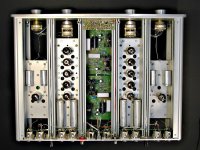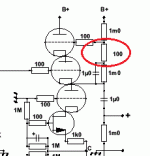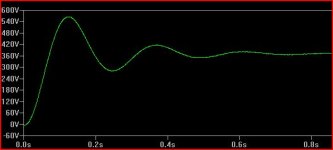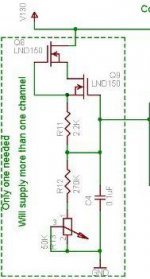Considering how poor the separation is on even the best carts, dual mono VCs are not going to make a skerrick of difference compared to a well laid out ganged VC.However, for best separation between the 2 channels, 2 separate volume controls and input switches are recommended.
The convenience is an issue. However, for best separation between the 2 channels, 2 separate volume controls and input switches are recommended.
My humble perception of the issue says that, with a balanced signal, there should be no issues of channel separation. To my mind, it's just a matter of whether you prefer to do one or two hand movements in order to change volume or input.
Oh, there's also an advantage of the two separate volume controls that I forgot to mention: it offers you the ability for balance control between two channels (if ever needed - personally, I did never need to change the balance between two channels)
Considering how poor the separation is on even the best carts, dual mono VCs are not going to make a skerrick of difference compared to a well laid out ganged VC.
My humble perception of the issue says that, with a balanced signal, there should be no issues of channel separation. To my mind, it's just a matter of whether you prefer to do one or two hand movements in order to change volume or input.
Oh, there's also an advantage of the two separate volume controls that I forgot to mention: it offers you the ability for balance control between two channels (if ever needed - personally, I did never need to change the balance between two channels)
Allen used 2 separate volume controls and 2 separate input selection switches.
In his book he wrote about the importance of the best possible separation between the channels.
This is DIY and everyone is free to play with each and every aspect of the design. So, each to ones' own.
In the RTP3C I intend to build, I'm going to follow all Allen's recommendations to the letter. This is because of I trust Allen, who arrived at his findings after very many years of experience. Also, I see clearly the technical aspects that justify all of his recommendations, but I don't want to enter any argument, or try to convince others. Each and every one is free to make choices according to ones' views.
OK, what technical aspect justifies this recommendation? Got something more than assertion to back it up?Also, I see clearly the technical aspects that justify all of his recommendations
I communicated with Allen over many years, and whilst I respect him, it doesn't mean I accept what he says all the time.
OK, what technical aspect justifies this recommendation? Got something more than assertion to back it up?
I communicated with Allen over many years, and whilst I respect him, it doesn't mean I accept what he says all the time.
As I wrote before, I'm not into arguments, or convincing others.
In a nut sell, whatever restrictions are there in the source concerning channel separation, adding such restrictions in the amplifier wouldn't improve the soundstage imaging. Interactions between the 2 channels in the amplifier itself will degrade whatever coming from the source, regardless of what happens in the source itself. The source may not be very good to begin with, the question is whether we care about further degrading the soundstage imaging in the amp.
As I wrote before, I'm not into arguments, or convincing others.
In a nut sell, whatever restrictions are there in the source concerning channel separation, adding such restrictions in the amplifier wouldn't improve the soundstage imaging. Interactions between the 2 channels in the amplifier itself will degrade whatever coming from the source, regardless of what happens in the source itself. The source may not be very good to begin with, the question is whether we care about further degrading the soundstage imaging in the amp.
I have to agree with Joshua on this one.
This, to me, is a very similar argument to the reason for us striving for the high-end at all. Why spend $500 for a quartet of 300Bs when most of the music we listen to was processed through a mixing desk full of cheap op-amps?
I find that the more effort I put into improving my electronics, the more I hear from my precious vinyl. Do I care about >1% of distortion? 30dB channel separation? Not really. The advantage of DIY is that it doesn't cost much more to do the job properly in the first place - this is why I use dual mono power supplies in my preamp and monoblock amps. Perhaps it's purely psychological - if I didn't go to these lengths to start with, I would probably spend far too long worrying whether I could still improve things like the channel separation. I personally am not overly bothered by dual controls (partly since every valve preamp I have owned has had them), and since there is a plausible logical argument for having them - there they are.
Alex
In my opinion you really have to use a stepped attenuator with the RTP3: the need for a 50K load for the phono stage means you can't use law-faking resistors on the pot (they would change the resistance of the pot), top-quality matched dual log pots are almost impossible to find, and linear pots have really poor control and matching at low volumes. I resorted to using 10K pots with a 40K series resistor on the input to get any real range at the lower end, but of course lost some of the upper end of the range as a result.
I have designed a 24-way stepped attenuator for my RTP3 to replace the Sfernice dual pots I have in there now. I have collected all the resistors, and am now waiting for the UK ELMA distributor to get hold of a couple of 24-way 4-pole switches for me.
I also think stepped attenuators are much better suited to dual controls than potentiometers, since you have repeatable volume settings.
Alex
I think the commercial unit is using a stereo DACT per channel. That's what it looks like to me.
Attachments
I think the commercial unit is using a stereo DACT per channel. That's what it looks like to me.
I think I would agree with that - the volume controls look like DACT, but the source select could be ELMA.
Alex
Jumper?
I'm sorry, do you mean it has no real electrical function?
I've seen schematics wich use a larger resistor in this position.
EDIT: this was on the RTP5 (47k), where allen still used mosfets, later on, when he switched back to tubes he kept using them, but very small (100 ohm)
Last edited:
Hi Alex
Sorry for the delay.
Here the simulation. You can see a overshoot at 550V. After 1s, you have a quite 36O v.
Vince
That's very interesting. I wonder whether the same transient response would be seen with a real shunt regulator connected to the supply: it may not instantaneously draw the maximum current, for instance. If that is the case, it may have some effect on the lifespan of some of the active devices in the regulator (for instance the IRF830 has a maximum rated voltage of 500V).
Just a thought - the HPHV regulator I use has a little 1uH choke at its input. What difference would this make to your simulation, I wonder?
Alex
Looking at the RTP3C schematic I noticed the LM329 is bypassed to ground with a 1uf capacitor. I guess the intention is to lower the input impedance to the 6922 at high frequency therefore shorting any possibility of interference noise that might cause oscillation. The thing is this 1uf will load the lm329 that preventing it from working properly.
I've built a similar 2sk146//6922 cascode using lm329 for voltage reference and bypass it with a 1uf Wima cap. In listening there is a lack of airiness, highs seem rolloff. Like there's a veil between me and the music. I found out the hard way that lm329 does not like capacitive load. After I yank the wima, the veil removed but noise floor increases causing soundstage to become more 2D and bass fullness reduced. For experiment, I replaced the lm329 with a resistor and a bypass cap (oscon). This restored the sonic balance n noise floor. Comparing to the lm329 with bypass, the later seem to offer more dynamic contrast and ambient information. Again this I suspect is the lower noise floor of the lm329 combo.
I did a search on some voltage regulator design where lm329 is used as a voltage reference for the error opamp. There is always a RC filter following the lm329 for providing a resistive load, input impedance matching for the opamp, and to reduce the lm329 noise.
Any one out there share a similar experience? The next thing I'm going to try is probably adding a RC filter to the lm329.
Regarding this issue with LM329, I was thinking of using the circuit I attach below. This is John Swenson's idea and was part of his BDT preamp as a voltage regulator for the upper gate of a MOSFET cascoded design. The idea is quite simple and clever: cascoded LND150s are used as a constant current source feeding a resistor; since LND150 has an Idss of ca. 0.33 mA, there is a voltage developed on the load resistor that is constant. And since LND 150 has a Vds of 500 V, it is very convenient for that purpose.
I'm about to use one of this for a PP-2C amp I'm currently building (or rather modifying to from an old PP amp).
What is your opinion on this regulator?
Attachments
Regarding this issue with LM329, I was thinking of using the circuit I attach below. This is John Swenson's idea and was part of his BDT preamp as a voltage regulator for the upper gate of a MOSFET cascoded design. The idea is quite simple and clever: cascoded LND150s are used as a constant current source feeding a resistor; since LND150 has an Idss of ca. 0.33 mA, there is a voltage developed on the load resistor that is constant. And since LND 150 has a Vds of 500 V, it is very convenient for that purpose.
I'm about to use one of this for a PP-2C amp I'm currently building (or rather modifying to from an old PP amp).
What is your opinion on this regulator?
This is the same method of voltage reference used in Gary Pimm CCS and I have used and like this CCS.
this method of providing voltage reference does not give a low impedance since it is "passive". Any grid current drawn by the tube will cause the reference voltage to move which is not what you want. In Gary CCS the voltage reference is for the MOSFET which is a different case than triode.
Nevertheless, I would suggest you try it and report your findings.
Cheers!
This is the same method of voltage reference used in Gary Pimm CCS and I have used and like this CCS.
this method of providing voltage reference does not give a low impedance since it is "passive". Any grid current drawn by the tube will cause the reference voltage to move which is not what you want. In Gary CCS the voltage reference is for the MOSFET which is a different case than triode.
Nevertheless, I would suggest you try it and report your findings.
Cheers!
Does this mean that the upper grid of the cascode draws current? And, if yes, how much is this current?
Evangelos
- Home
- Amplifiers
- Tubes / Valves
- Vacuum State RTP3C



